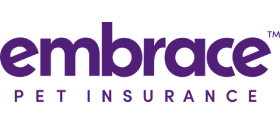10 Best pet insurance companies & plans of November 2023
Updated 12:52 p.m. UTC Nov. 22, 2023
Editorial Note: Blueprint may earn a commission from affiliate partner links featured here on our site. This commission does not influence our editors' opinions or evaluations. Please view our full advertiser disclosure policy.
ManyPets, Embrace, Paw Protect, Pets Best and Spot are the best pet insurance companies, according to our analysis.
We evaluated pet insurance plans to determine the best pet insurance companies based on cost and coverage. Use this rating as a starting point to compare plans and find the best for your situation.
The best pet insurance companies of 2023
- ManyPets: Best for affordable rates
- Embrace: Best for a diminishing deductible
- Paw Protect: Best for flexible vet payment options
- Pets Best: Best for direct vet payment
- Spot: Best for annual coverage options
- MetLife: Best for discounts and perks
- Figo: Great for 100% reimbursement coverage
- Lemonade: Best for fast claims processing
- Pumpkin: Best for preventative care
- Trupanion: Best for reimbursement amount
Why trust our pet insurance experts
Our team of experts evaluates hundreds of pet insurance products and analyzes thousands of data points to help you find the best product for your situation. We use a data-driven methodology to determine each rating. Advertisers do not influence our editorial content. You can read more about our methodology below.
- 2,295 rates reviewed
- 360 coverage details evaluated
- 5 levels of fact-checking
Paw Protect
Top-rated pet insurance companies of 2023
Summary: Pet insurance reviews for 2023
| Pet insurance company | Our rating | Deductible choices | Reimbursement level choices | Annual limit choices | Monthly pet insurance for a dog | LEARN MORE | ||
|---|---|---|---|---|---|---|---|---|
| ManyPets | 5.0 stars | $500 | 70%, 80% | Unlimited | $36 | Compare Rates | Via Petted's Website | |
| Pets Best | 5.0 stars | $50, $100, $200, $250, $500, $1,000 | 70%, 80%, 90% | $5,000 or Unlimited | $50 | Compare Rates | Via Petted's Website | |
| Embrace | 5.0 stars | $100, $250, $500 | 70%, 80%, 90% | $5,000 to Unlimited | $58 | Compare Rates | Via Petted's Website | |
| Paw Protect | 5.0 stars | $100, $250, $500 | 70%, 80%, 90% | $5,000 to Unlimited | $58 | Compare Rates | Via Petted's Website | |
| Spot | 5.0 stars | $100, $250, $500, $750, $1,000 | 70%, 80%, 90% | $2,500 to Unlimited | $59 | Compare Rates | Via Petted's Website | |
| MetLife | 4.5 stars | $0 - $2,500 | 50%, 70%, 80%, 90% | $0 to Unlimited | $51 | Compare Rates | Via Petted's Website | |
| Figo | 4.0 stars | $100, $250, $500, $750 | 70%, 80%, 90%, 100% | $5,000 to Unlimited | $55 | Compare Rates | Via Petted's Website | |
| Lemonade | 4.0 stars | $100, $250, $500 | 70% to 90% | $5,000 to $100,000 | $55 | Compare Rates | Via Petted's Website | Via Petted's Website |
| Pumpkin | 4.0 stars | $100, $250, $500 | 90% | $10,000 to Unlimited | $60 | Compare Rates | Via Petted's Website | |
| Trupanion | 4.0 stars | No deductible | 50% to 100% | Unlimited | $60 | Compare Rates | Via Petted's Website |
Average monthly pet insurance cost assumes unlimited reimbursement (or the highest level offered by that company), a $500 deductible and a 90% reimbursement percentage for a dog insurance accident and illness plan. These average pet insurance company rates are based on dogs of various ages, breeds and ZIP codes. Source: PetInsurer.com.
Methodology
To find the best pet insurance, we analyzed 18 pet insurance companies using data provided by PetInsurer.com.
Each pet insurance company was eligible for up to 100 points, based on its performance in the following key categories:
Cost: 50 points. We calculated average rates for accident and illness pet insurance plans for dogs with unlimited annual reimbursement (or the highest level offered by that pet insurance company), a $500 deductible and a 90% reimbursement percentage. Average rates were based on quotes for 10 dog breeds, three age groups and multiple ZIP codes. The lower the average rate, the higher the number of points
Annual coverage limits: 10 points. Pet insurance companies that offer an annual reimbursement level of $100,000, or unlimited annual coverage scored in this category.
24/7 vet line: 10 points. Insurance companies that offer access to a 24/7 vet line earned points. Being able to call for medical advice might save you money on vet visits.
Routine wellness plan: 10 points. Pet insurance companies that offer an optional wellness plan add-on scored points. Wellness plans can reimburse you for preventative care for your pet.
Pays vet exam fees: 10 points. If a pet insurance plan includes pet exam fees, the insurer received 10 points. If this is offered as a coverage add on, the insurer received 5 points.
Behavioral therapy: 5 points. If a pet insurance company covers behavior therapy in its pet insurance plans, it scored points.
Euthanasia or end of life expenses included: 5 points. If euthanasia or other end of life expenses are covered in pet insurance plans, a pet insurance company scored in this category.
Why some pet insurance companies didn’t make the cut
Of the 18 pet insurance companies we evaluated, nine made our rating of the best pet insurance companies. Companies with higher-than-average rates for accident and illness pet insurance plans, or those with less coverage for comparable cost, did not make the cut.
What is pet insurance?
Pet insurance, also called pet health insurance, is designed to reimburse you for your pet’s unexpected and unforeseen veterinary expenses.
- Deductible. Pet health plans typically have a deductible, which is the amount you have to pay in vet bills before your pet insurance starts to pay.
- Reimbursement. After reaching your deductible, your pet insurance company will reimburse you for a percentage of your eligible expenses, up to an annual maximum. Only a few pet insurance companies pay the vet directly.
What does pet insurance cover?
What pet insurance covers depends on the type of plan you buy. There are three main types of pet insurance plans.
- Accident-only: Accident-only pet insurance plans tend to be the cheapest form of coverage. They cover the diagnosis and treatment of injuries resulting from accidents, such as lacerations, poisoning, car accidents and foreign body ingestion. These policies do not provide any coverage for illnesses or chronic conditions.
- Accident and illness: The most popular form of pet insurance, accident and illness plans provide coverage for the diagnosis and treatment of injuries and illnesses. This coverage includes accident benefits plus coverage for illnesses such as cancer, digestive problems and infections.
- Wellness: Wellness plans can often be added to an accident and illness plan, to provide some routine or preventative benefits. If you want the best pet insurance for preventative care, shop for pet insurance plans that offer an optional wellness plan add-on and compare what these plans cover.
What doesn't pet insurance cover?
While pet insurance covers unexpected injuries or illnesses, it doesn’t cover everything, such as non-curable pre-existing conditions. Here are some common pet insurance exclusions:
- Pre-existing conditions. A pre-existing condition is any issue your pet was seen at the vet for or diagnosed with prior to its pet insurance policy effective date or during the policy waiting period. For example, if your cat has arthritis, the pet insurance company will deny any claims related to treatments for that condition. While pet insurance doesn’t cover pre-existing conditions, some companies will cover conditions they deem curable. The best pet insurance for pre-existing conditions is a plan that covers certain curable pre-existing conditions if the condition doesn’t reappear for a certain period of time, like a year.
- Routine care. Pet insurance doesn’t cover preventative or routine care, such as spaying or neutering, vaccinations, wellness exams or parasite prevention. The best pet insurance for routine care includes a wellness plan add-on that will reimburse you for some of those expenses.
- Dental care. Accident and illness plans typically cover dental accidents and illnesses, but routine dental care is usually not covered unless you have a wellness plan. If you’re looking for the best pet insurance for dental care, you’ll want to shop for coverage with a wellness plan add-on that includes routine dental care.
- Elective or experimental treatments. Pet insurance doesn’t cover elective or cosmetic treatments, such as tail or ear docking or root canals. It also doesn’t cover experimental treatments or clinical trials.
- Exam fees. Some pet insurance plans won’t cover your vet exam fees, even when related to an accident or illness.
- Breeding. Pet insurance doesn’t cover treatments related to injuries or accidents resulting from breeding, whelping (for dogs) or queening (for cats). However, some pet insurance companies, such as Trupanion, offer riders for pets that will be used for breeding.
- Boarding and kennel fees. Most pet insurance plans won’t cover the cost of boarding or kenneling your pet, but some might if you have add-on coverage. For instance, Trupanion offers an optional pet owner assistance package that covers boarding fees if you, the owner, are hospitalized.
- Grooming. Fees for grooming, shampooing and nail trims are not covered by pet insurance.
- Pet food. While pet insurance does not cover your pet’s regular food and supplements, some plans cover prescription pet food.
Best pet insurance for dogs in 2023
Embrace, ManyPets, Paw Protect, Pets Best and Spot have the best dog insurance, based on our analysis of accident and illness plans. These top-scoring pet insurance companies have competitive cost and coverage options.
- ManyPets offers the best affordable pet insurance for dogs if you’re looking to save on rates.
- Embrace is best for a diminishing deductible.
- Paw Protect is best for flexible vet payment options.
- Pets Best is best for direct vet payments, so you don’t have to wait on reimbursement.
- Spot is best for annual coverage options.
Best pet insurance for puppies
Lemonade has the best pet insurance for puppies of the companies we analyzed, based on price. The average cost of a Lemonade accident and illness plan with $100,000 in annual coverage, 90% reimbursement and a $500 deductible for a 3-month-old puppy is $32 per month.
Pumpkin is also a good choice for puppy pet insurance if you’re interested in a wellness plan. Dogs under 6 months can get extensive preventative care through Pumpkin’s add-on Preventative Essentials plan.
Best pet insurance for senior dogs
Pumpkin has some of the best dog insurance for older dogs. It has no special waiting period for problems like knee injuries or hip dysplasia and it provides coverage for virtual vet visits. Pumpkin has no upper age restrictions and no reducing coverage as your pet ages.
Best pet insurance for cats in 2023
Pets Best has the best cat insurance of the pet insurance companies in our rating, based on cost. A Pets Best accident and illness plan for cats with unlimited coverage has an average monthly cost of $27.
Best pet insurance for kittens
Pets Best offers the best cat insurance for young pets, based on the average rates we reviewed. To insure a 3-month-old kitten with unlimited annual coverage from Pets Best will cost you about $21 a month.
Best pet insurance for pre-existing conditions
Pet insurance won’t cover pre-existing conditions, including anything your pet showed symptoms for before pet insurance coverage starts or during a waiting period.
However, some companies will cover certain issues if the pre-existing condition is considered curable, such as a paw fracture or upper respiratory infection, and if your pet has been free of symptoms and treatment for a certain time period.
Embrace, ManyPets, Paw Protect, Pets Best and Spot all cover select curable pre-existing conditions. It’s important to understand which conditions each company considers curable, and how long it takes to be considered cured, before buying a plan.
Have a pet with pre-existing conditions? Pet insurance and pre-existing conditions
How does pet insurance work?
Pet health insurance works by reimbursing you for a portion of your pet’s medical expenses. When you purchase a policy, you typically choose a deductible, reimbursement level and reimbursement percentage.
- Deductible: Similar to a health insurance deductible, a pet insurance deductible is the amount of money you are responsible for paying, before your pet insurance starts to reimburse you. Some insurers have an annual deductible, while others have a per-condition deductible. Deductibles typically range from $0 to $1,000. In general, the lower your deductible, the higher your pet insurance rate.
- Reimbursement percentage: After reaching your deductible, your pet insurance company usually pays a percentage of the remaining claim amount. Most companies will reimburse only 70% to 90% of the vet bill. Some, like Figo, offer a 100% reimbursement percentage, but choosing this option will increase your pet insurance rate.
- Annual coverage limit: This is the maximum amount your insurer will pay in a year. Some companies cap reimbursements at $15,000 or less, while some offer unlimited reimbursement.
The majority of pet insurance companies operate via reimbursement. You pay for your pet’s care and submit a claim afterward. The insurer reviews your claim and, if it’s approved, will send you a reimbursement check for the covered amount. Some pet insurance companies offer direct veterinary payments, but they are the exception to the rule.
How much is pet insurance?
Americans spent $35.9 billion on vet services last year, according to the American Pet Products Association, and we’re projected to spend $37 billion this year. Vet care can break your budget if you haven’t planned ahead by saving or buying affordable pet insurance that meets your pet’s needs.
Average cost of pet insurance for dogs
The average cost of pet insurance for dogs is:
- $45 per month for $5,000 of annual coverage.
- $55 per month for a policy with unlimited annual coverage.
Average cost of pet insurance for cats
Pet insurance for cats costs an average of:
- $30 per month for $5,000 of annual coverage.
- $47 per month for unlimited coverage.
Pet insurance costs by state
Source Petinsurer.com. Average monthly rates are for pet health insurance for dogs available in that state with a $250 deductible and 90% reimbursement level, or the closest available. Pet insurance rates are the average of a dog insurance plan for a medium mixed-breed dog at two ages: 3 months and 3 years. One ZIP code was used per state. Your rates will vary based on your ZIP code, the pet insurance company you choose and other factors.
Factors that affect your pet insurance costs
How much you pay for pet insurance will depend on several factors.
- Type of pet: Pet insurance for cats is typically cheaper than pet insurance for dogs.
- Breed: Some breeds are more prone to illnesses and hereditary issues that could lead to higher medical expenses.
- Age: Older pets cost more to insure because they are more likely to have health issues that require veterinary care.
- Gender: Female pets are about 5% cheaper to insure, according to the National Association of Insurance Commissioners.
- Location: If you live in a city where vet expenses are higher, that will be factored into the cost of your pet insurance.
- Coverage options: When you buy pet insurance, you’ll choose an annual coverage limit, deductible and reimbursement level. To save on your pet insurance premium, you could choose a low annual maximum, a high deductible and a low reimbursement level. However, this means you’ll get a smaller payout when you file a claim than you would if you had a low deductible and high reimbursement percentage.
How to compare pet insurance: Compare pet insurance quotes
How to save on pet insurance
Many pet insurance companies offer discounts that can make pet insurance more affordable. Common pet insurance discounts include:
- Multi-pet discounts: If you enroll two or more pets, you may qualify for a discount. To find the best pet insurance for multiple pets, get several quotes to compare savings across pet insurance companies.
- Upfront payment discounts: If you pay your pet insurance in one lump sum rather than opting for monthly or quarterly payments, you may qualify for a discount.
- Military pet insurance discount: If you are a military service member or veteran, you may qualify for a discount.
How to compare the best pet insurance companies
When you’re ready to compare pet insurance online quotes, here are some considerations.
- Select the same variables. Choose the same deductible, annual reimbursement limit, reimbursement percentage and upgrades, such as a wellness plan. This ensures you are comparing apples to apples when it comes to the cost of pet insurance.
- Consider more than pet insurance cost. Compare what each pet insurance plan covers and excludes. If you’re considering adding a wellness plan, make sure it covers the services you want, such as spaying and neutering.
- If your pet has pre-existing conditions, dig into each pet insurance plan’s details to learn what the insurer may cover, such as certain curable conditions.
- Read pet insurance reviews, such as the customer reviews on Trustpilot. Look for reasons recent claims were denied.
Is pet insurance worth it?
Pet insurance may be worth it if you consider how much vet bills could add up to in an emergency situation.
In a 2023 MetLife pet insurance study, 59% of pet owners who have pet insurance said their financial health had improved during the past year, while only 32% of those without pet insurance said the same.
“Accidents can happen to any pet, regardless of age,” said Brian Jorgensen, head of MetLife Pet Insurance. “In the U.S., a pet receives medical care every 2.5 seconds, and 1 in 3 pets need emergency veterinary treatments every year.”
Pet insurance claims
According to the 2023 NAPHIA State of the Industry Report, the most common medical conditions for dogs and cats in North America in 2022 were as follows.
- Ear infections.
- Vomiting.
- Diarrhea.
- Urinary tract infection.
- Weight loss.
Top pet insurance claims paid
The most expensive dog insurance claims paid in 2022, per the NAPHIA report, were:
- $60,882 for a 2-year-old flat-coated retriever in New Hampshire with pneumonia.
- $60,215 for a 3-year-old English bulldog in Texas with pneumonia.
- $52,659 for a 10-year-old Akita with heart issues.
- $51,922 for a 4-year-old mixed-breed dog with a wound.
The top cat insurance claims paid were:
- $40,057 for a 2-year-old Sphynx in New Jersey with a number of health issues and a pyothorax sepsis tail (tip) amputation.
- $29,503 for a 6-year-old domestic short hair in California with acquired esophageal dysfunction.
- $21,941 for a 5-year-old domestic medium hair that needed treatment after swallowing a foreign body.
- $20,154 for a 12-year-old domestic short hair for renal failure.
States with the highest average claim amounts
Washington, D.C. had the highest average claim amount in Oct. 2023, at $625 per pet insurance claim. Maine came in next with an average claim amount of $554, according to data provided by Embrace pet insurance.
Source: Embrace. Average cost per pet insurance claim by state in Oct. 2023.
Many states saw a significant month-over-month increase in the average cost per pet insurance claim from Sept. to Oct. 2023. Indiana had a 50% increase in claim costs, Mississippi had a 36% increase and Idaho saw a 23% increase. The average claim cost for all states has risen 17.6% since 2021.
Most expensive dog breeds for pet insurance
Breeds with a higher risk of developing certain illnesses and injuries that could lead to costly surgeries or treatments will cost more to insure than heartier breeds, including mixed dog breeds.
Comparing the cost of pet insurance for 367 dog breeds, our insurance experts found that 13 breeds have a very high pet insurance rate compared to other dog breeds. These dog breeds are often the most expensive dogs to insure:
- Mastiff
- Boerboel
- Saint Bernard
ManyPets offers the best pet insurance overall, according to our analysis. Embrace, Paw Protect, Pets Best and Spot also get 5 stars in our rating. These top pet insurance companies’ accident and illness plans have competitive rates and coverage options.
Your deductible is the amount of money you are responsible for paying before your pet insurance company will start to reimburse you for eligible veterinary expenses.
Say you buy pet insurance and your first vet bill for covered care is $1,000. If you have a $500 deductible and a 90% reimbursement level, you will be reimbursed $450 (90% of the remaining $500 after your deductible is subtracted from $1,000).
No, pet insurance companies don’t cover pre-existing conditions. However, some companies will consider certain pre-existing conditions “cured” if the pet is symptom-free for a certain number of days. This will vary by insurer, so make sure you understand the terms and conditions before committing to a plan.
Pet insurance covers unexpected injuries or illnesses, not routine care. Wellness exams aren’t covered unless you purchase a wellness plan or rider to your accident and illness plan.
Pet insurance is not tax-deductible, but you may be able to write off a portion of your pet’s medical expenses if your pet is a certified service animal, like a guide dog.
You might also be able to claim vet bills on your taxes if:
- You are fostering a pet for a nonprofit organization that is registered with the IRS.
- Your pet is established as a business animal such as a guard dog if you are self-employed.
- Your pet generates income for you, like a show dog or pet influencer with a monetized YouTube channel.
You can typically still buy pet insurance after your pet receives a diagnosis, but that health condition will be excluded from coverage as a pre-existing condition. Depending on the diagnosis, you may only be able to purchase a basic accident-only plan.
The best time to buy pet insurance is when your pet is young. Pet insurance for puppies and kittens is more affordable than insuring an older pet, and at a young age your pet is less likely to have a pre-existing condition that would be excluded from pet insurance coverage.
Pet insurance accident and illness plans do not typically cover spaying and neutering, but you can often get coverage through a wellness plan.
One exception may be if your pet develops a condition that makes spaying or neutering a medical necessity. If your pet is already enrolled in an accident and illness plan, and its medical condition does not predate the pet insurance coverage, desexing might be covered.
More pet insurance ratings
- Best cheap pet insurance
- Best pet insurance for multiple pets
- Does pet insurance cover pre-existing conditions?
- Pet dental insurance explained
- Compare pet insurance quotes
Best pet insurance in your area
- Best pet insurance in California
- Best pet insurance in Colorado
- Best pet insurance in New York
- Best pet insurance in Texas
Pet insurance reviews
Editor’s Note: This article contains updated information from previously published stories:
- Dog days of the pandemic create a thriving economy for man’s best friend
- VA: Fatal dog experiments moving ahead despite criticism from Congress, veterans groups
- Happy news: Pet adoptions are way up amid coronavirus crisis, even with shelters closed to public
- Forget dogs and cats. The most pampered pets of the moment might be our backyard chickens
- Pet insurance is now booming
Blueprint is an independent publisher and comparison service, not an investment advisor. The information provided is for educational purposes only and we encourage you to seek personalized advice from qualified professionals regarding specific financial decisions. Past performance is not indicative of future results.
Blueprint has an advertiser disclosure policy. The opinions, analyses, reviews or recommendations expressed in this article are those of the Blueprint editorial staff alone. Blueprint adheres to strict editorial integrity standards. The information is accurate as of the publish date, but always check the provider’s website for the most current information.




























